|
|
|
|
|
Oil On
Canvas, Real Flavor of Old Masters
|
|

|
ARTWORKS
INDEX
A B C D E F G H I J K L M N O P Q R S T U V W X Y Z |
ARTISTS
INDEX
A B C D E F G H I J K L M N O P Q R S T U V W X Y Z |
|
|
| | |
|
|
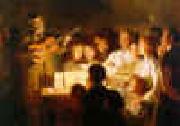 |
Victor Gilbert -- Click Here
|
|
1847-1935
French
Victor Gilbert Gallery |
|
 |
Victor Forsell -- Click Here
|
|
painted Motiv fran Stockholms omgivningar in 1846-1931 |
|
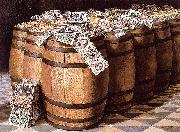 |
Victor Dubreuil -- Click Here
|
|
French-born American Painter, active 1886-ca.1900. |
|
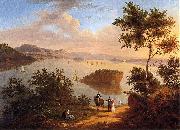 |
Victor DeGrailly -- Click Here
|
|
painted Passamaquoddy Bay, Maine in c1840
|
|
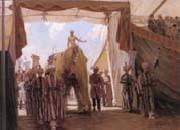 |
Victor C.Anderson -- Click Here
|
|
a well known Hudson River School painter,
American , 1882-1937
was an American painter and illustrator, primarily known for his rural life scenes and landscapes, whose works were featured in Life and other magazines of the early 20th Century, and who produced a wide range of illustrations for books as well as oil paintings. Like his father, Frank Anderson, Victor was a well-known painter of the Hudson River School. Victor drew and painted from an early age, eventually entering the Pratt Institute in Brooklyn. His favorite subjects were scenes of homespun rural life and landscapes of the late 19th and early 20th Centuries, and were popular nationally. For many years, he lived and had his studio at 195 Battle Avenue, White Plains, New York, where he died in 1937. He exhibited in the National Academy. His daughter, Joan Howe (1915-2005), was a well-known watercolor artist . |
|
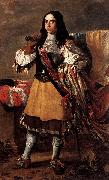 |
Victor Boucquet -- Click Here
|
|
Victor Boucquet, a Flemish painter, was born at Veurne in 1619. He was the son of Marcus Boucquet, a painter little known. Descamps supposes he must have visited Italy, as his works exhibit a manner that partakes little of the taste of his country. He painted historical subjects, and was also esteemed as a portrait painter. His works are distributed in the different churches of the towns in Flanders. They are well composed, and, like those of most of the artists of his country, are well coloured. In the great church of Nieuport are two altar-pieces by this master, one of which, representing 'The Death of St. Francis,' is particularly admired; and in the town-house there is a large picture by him, considered as his principal work, representing 'The Judgment of Cambyses.' The principal altar-piece in the church at Ostend is by Boucquet: it represents the Taking down from the Cross. He died at Furnes in 1677. |
|
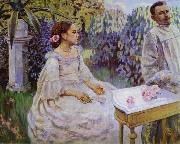 |
Victor Borisov-Musatov -- Click Here
|
|
(Russian), (April 14 [O.S. April 2] 1870 - November 8 [O.S. October 26] 1905) was a Russian painter, prominent for his unique Post-Impressionistic style that mixed Symbolism, pure decorative style and realism. Together with Mikhail Vrubel he is often referred as the creator of Russian Symbolism style.
Victor Musatov was born in Saratov, Russia (he added the last name Borisov later). His father was a minor railway official who had been born as a serf. In his childhood he suffered a spinal injury, which made him humpbacked for the rest of his life. In 1884 he entered Saratov real school, where his talents as an artist were discovered by his teachers Fedor Vasiliev and Konovalov.
He was enrolled in the Moscow School of Painting, Sculpture and Architecture in 1890, transferring the next year to the Imperial Academy of Arts in Saint-Petersburg, where he was a pupil of Pavel Chistyakov. The damp climate of Saint-Petersburg was not good for Victor's health and in 1893 he was forced to return to Moscow and re-enroll to the Moscow School of painting, sculpturing and architecture. His earlier works like May flowers, 1894 were labelled decadent by the school administration, who sharply criticised him for making no distinction between the girls and the apple trees in his quest for a decorative effect. The same works however were praised by his peers, who considered him to be the leader of the new art movement.
The Pool. 1902In 1895 Victor once again left Moscow School of painting, sculpturing and architecture and enrolled in Fernand Cormon's school in Paris. He studied there for three years, returning in summer months to Saratov. He was fascinated by the art of his French contemporaries, and especially by the paintings of "the father of French Symbolism" Pierre Puvis de Chavannes and by the work of Berthe Morisot.
In 1898 Borisov-Musatov returned to Russia and almost immediately fell into what it is called "fin de siecle nostalgia". He complained about "the cruel, the truly iron age", "dirt and boredom", "devil's bog", and he had acute money problems that were somewhat alleviated only in the last years of his life when collectors started to buy his paintings. Musatov's response was creating a half-illusory world of the 19th century nobility, their parks and country-seats. This world was partially based on the estate of princes Prozorvky-Galitzines Zubrilovka and partially just on Musatov's imagination. Borisov-Musatov also abandoned oil-paintings for the mixed tempera and watercolor and pastel techniques that he found more suitable for the subtle visual effects he was trying to create.
|
|
|
|
Vicente Palmaroli Gonzalez -- Click Here
|
|
1834-1896
Spanish
Vicente Palmaroli Gonzalez Gallery
His father was the Italian lithographer, Gaetano Palmaroli and he studied in San Fernando's Royal Academy. He later went to Rome in 1857 to complete his training, and he lived there until 1866. One year later, he went to the Paris World's Fair of 1867. He met Ernest Meissonier, who influenced his later works.
He was academician in San Fernando's Royal Academy, and director in the Spanish Academy in Rome and Prado Museum (1893-1896). |
|
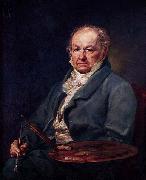 |
Vicente Lopez y Portana -- Click Here
|
|
(September 19, 1772, Valencia, Spain CJuly 22, 1850, Madrid, Spain) was a Spanish painter, considered the best portrait painter of his time.
Vicente Lepez y Portaña was born in Valencia on September 19, 1772. His parents were Cristebal Lepez Sanchordi and Manuela Portaña Meer. Vicente Lepez began formally studying painting in Valencia at the age of thirteen, he was a disciple of father Antonio de Villanueva, a Franciscan monk, and he studied at the Academy of San Carlos in his native city. He was seventeen when he won first prize in drawing and coloring receiving a scholarship to study in the prestigious Academia Real de Bellas Artes de San Fernando in Madrid. For the following three years in Madrid, he apprenticed with the Valencian painter, Mariano Salvador Maella. Vicente Lepez returned to Valencia in 1794 and subsequently became vice-director of painting at the Academy where he had studied as a boy. In 1795 he married Maria Piquer, they had two sons: Bernardo Lepez Piquer and Luis (1802-1865), who were also painters, following their father's style but with little accomplishments. In 1801 Lepez was named President of the Academy of San Carlos. |
|
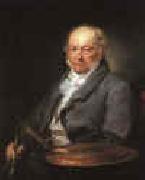 |
Vicente Lopez -- Click Here
|
|
1772-1850
Spanish
Vicente Lopez Gallery
was an Argentine writer and politician who acted as interim President of Argentina from July 7, 1827 to August 18, 1827. He also wrote the lyrics of the Argentine National Anthem adopted in May 11, 1813.
Lopez began his primary studies in the San Francisco School, and later studied in the Real Colegio San Carlos, today the Colegio Nacional de Buenos Aires. He obtained a doctorate of laws in the University of Chuquisaca. He served as a captain in the Patriotic Regiment during the English invasions. After the Argentine victory he composed a poem entitled El triunfo argentino (The Argentine Triumph). He participated in the Cabildo Abierto of May 22, 1810 and supported the formation of the Primera Junta. He had good relations with Manuel Belgrano. When the royalist members of the city government of Buenos Aires were expulsed, he was elected mayor of the city; he was an enemy of the party of Cornelio Saavedra and one of the creators of the First Triumvirate, of which he was the Treasurer.
Lopez was a member of the Constituent Assembly of year XIII, representing Buenos Aires. At the request of the Assembly, he wrote the lyrics to a "patriotic march", which eventually became the Argentine National Anthem. It was a military march, whose music was composed by the Catalan Blas Parera; it was approved on March 11, 1813. The first public reading was at a tertulia on May 7 in the house of Mariquita Sanchez de Thompson. It displaced a different march, written by Esteban de Luca, which would have been the hymn if not for the more militaristic Lopez. |
|
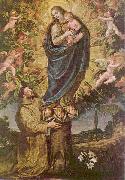 |
Vicente Carducho -- Click Here
|
|
(in Spanish, sometimes Vicencio or Vicente Carducho; 1568-1638) was an Italian painter.
He was born in Florence, and was trained as a painter by his brother Bartolomeo, whom he followed to Madrid as a boy.
He Initially painted some works at Valladolid and helped his brother in painting at the Escorial for Philip II of Spain. He returned to the court of Philip III in Madrid in 1606 and helped decorate the recently rebuilt Palacio del Pardo. While at work his brother died, and Vicente took his place. He painted there a history of Achilles. When finished, he was employed for four years by the monks of the Chartreuse of el Paular to decorate their monastery with 55 canvases of historical figures the great cloister. 27 represent the live of St. Bruno, 27 of martyrs.
He worked a great deal for the subsequent monarch, Philip IV, and his best pictures are those he executed for him as decorations in the Prado. Examples of his work are preserved at Toledo, Segovia, and several other Spanish cities. For many years he labored in Madrid as a teacher of his art, and among his pupils were Giovanni Ricci, Pedro Obregon, Vela,[disambiguation needed ] Francisco Collantes, and other distinguished representatives of the Spanish school during the 17th century.
He also authored a treatise, De las Excelencias de la Pintura or Dielogos de la pintura, su defensa, origen, essencia, definicien, modos, y differencias, published in 1633. Written in classical tradition as a dialogue between a master and an apprentice. Following strict piety of the Spanish realm,
|
|
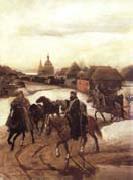 |
Viacheslav Schwarz -- Click Here
|
|
Australian,1838-69
|
|
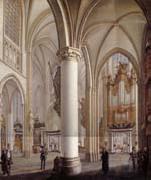 |
Vervloet Francois -- Click Here
|
|
Malines 1795-Venise 1872 |
|
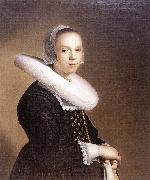 |
VERSPRONCK, Jan Cornelisz -- Click Here
|
|
b. ca. 1597, Haarlem, d. 1662, Haarlem |
|
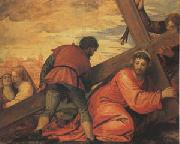 |
Veronese and Studio -- Click Here
|
|
b.Verona 1528 - d.Venice 1588 |
|
_a.jpg) |
VERONESE (Paolo Caliari) -- Click Here
|
|
Italian Mannerist Painter, ca.1528-1588 |
|
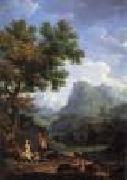 |
VERNET, Claude-Joseph -- Click Here
|
|
French Painter, 1714-1789
Painter. Vernet probably received his first lessons in painting from his father, Antoine, who then encouraged him to move to the studio of Philippe Sauvan (1697-1792), the leading master in Avignon. Sauvan supplied altarpieces to local churches and decorative works and mythologies for grand houses in the area. After this apprenticeship Vernet worked in Aix-en-Provence with the decorative painter Jacques Viali ( fl 1681- 1745), who also painted landscapes and marine pictures. In 1731 Vernet independently produced a suite of decorative overdoors for the h?tel of the Marquise de Simiane at Aix-en-Provence; at least two of these survive (in situ) and are Vernet's earliest datable landscapes. These are early indications of his favoured type of subject, and Vernet would have studied works attributed to such 17th-century masters as Claude Lorrain, Gaspard Dughet and Salvator Rosa in private collections at Aix and Avignon. Three years later Joseph de Seytres, Marquis de Caumont, who had previously recommended Vernet to the Marquise de Simiane, offered to sponsor a trip to Italy. |
|
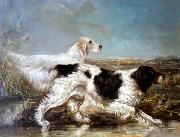 |
Verner Moore White -- Click Here
|
|
Verner Moore White (October 5, 1863 - August 30, 1923), born Thomas Verner Moore White but informally known as Verner White, was an American landscape and portrait painter. White painted works for many of the business and political leaders of his time including commissions for three United States Presidents.
|
|
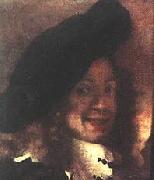 |
VERMEER VAN DELFT, Jan -- Click Here
|
|
Dutch Baroque Era Painter, 1632-1675 |
|
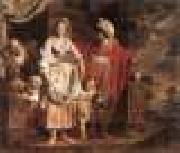 |
VERHAGHEN, Pieter Jozef -- Click Here
|
|
Flemish painter (b. 1728, Aarschot, d. 1811, Leuven).
|
|
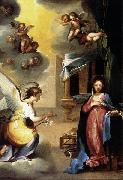 |
Ventura Salimbeni -- Click Here
|
|
(also later called Bevilacqua; 20 January 1568 - 1613) was an Italian Mannerist painter and printmaker and among the last representatives of a style influenced by the earlier Sienese School of Quattrocento-Renaissance.
Salimbeni was born in Siena. He studied painting, together with his half-brother Francesco Vanni, under their father Arcangelo Salimbeni in his native Siena,
He possibly spent some time,in Northern Italy and then moved to Rome in 1588 to work, together with others, on the fresco painting of the Vatican Library under pope Sixtus V.
During 1590-1591, he got a commission by Cardinal Bonifazio Bevilacqua Aldobrandini for paintings in the Roman Jesuit Church of the Gese and the Basilica di Santa Maria Maggiore. These paintings show the influence of the Mannerist Cavalier D'Arpino and Andrea Lillio.
Salimbeni returned to Siena in 1595. Here he became one of the last leaders of the Mannerist school, in this period between Mannerism and Baroque. He was here influenced by Federico Barocci as can be seen in the draperies, highlighted with abrupt changes of light and flickering surfaces, of his painting "Birth of a Virgin" in the San Domenico church in Ferrara (1607-1608).
He completed painting cycles (1595-1602) for Sienese churches such as the oratory in the Santa Trinite. He is known for detailed preparatory drawings, most of which are now in the Uffizi in Florence or the Fine Arts Museum of San Francisco. He started around 1600 painting the scenes from the "Life of St. Hyacinth" for the Sienese church of Santo Spirito. These paintings show the awkward perspective of the style of the Sienese Mannerist painter Beccafumi in the backdrop of buildings and landscape. In Siena, Salimbeni completed several painting cycles for the church of Santo Spirito. He continued to create paintings for churches throughout Italy, including Florence. At the Basilica della Santissima Annunziata di Firenze, he frescoed lunettes (1605-1608) illustrating events in the history of the Servite Order. In the Duomo di San Salvatore, he executed a magnificent John the Baptist.
At about the same time, around 1600, he got an assignment in Assisi for a fresco of the "Resurrection of Christ" and the "Dying Saint Clare is visited by the pope" in the vault of chapel of San Massimo in the Basilica of Santa Maria degli Angeli.
Salimbeni got in 1603 the commission to paint frescoes with scenes from the church's patron saints in the church of Quirico and Giulitta, one of the oldest churches in Siena. As in the church of Santa Trinite, he worked here alongside with the painter Alessandro Casolari.
This was a period on non-stop new assignments : three paintings for the church San Lorenzo in San Pietro in Montalcino, the "Donation of the Keys" (1599), the "Disputa of the Eucharist" (1600) and the "Crucifixion" (1604).
At the same time he was painting the "Vision of Gregory the great" and the "Punishment of David" in the Basilica of San Pietro in Perugia. The papal legate, cardinal Bonifazio Bevilacqua (1571-1627), who had commissioned these paintings, was so pleased that he invested Ventura Salimbeni with the Order of the Golden Spur, a very selective papal order. He was even authorized from now on to name himself Cavalieri Bevilacqua. He painted the canvas of the Ascension of the Virgin (1607) for San Frediano in Pisa.
In 1612 he painted the "Life of Saint Galganus" for the Chiesa del Santuccio in Siena with the hermit saint set in a wooded landscape.
His last work of art was the oil painting the "Marriage of the Virgin" for the Seminario diocesano in Foligno in 1613.
|
|
 |
VELDE, Willem van de, the Younger -- Click Here
|
|
Dutch painter (b. 1633, Leiden, d. 1707, London).
was a Dutch marine painter. Willem van de Velde was baptised on 18 December 1633 in Leiden, Holland, Dutch Republic. A son of Willem van de Velde the Elder, also a painter of sea-pieces, Willem van de Velde, the younger, was instructed by his father, and afterwards by Simon de Vlieger, a marine painter of repute at the time, and had achieved great celebrity by his art before he came to London. In 1673 he moved to England, where he was engaged by Charles II, at a salary of £100, to aid his father in "taking and making draughts of sea-fights", his part of the work being to reproduce in color the drawings of the elder van de Velde. He was also patronized by the Duke of York and by various members of the nobility. He died on 6 April 1707 in London, England. Most of Van de Velde's finest works represent views off the coast of Holland, with Dutch shipping. His best productions are delicate, spirited and finished in handling, and correct in the drawing of the vessels and their rigging. The numerous figures are tellingly introduced, and the artist is successful in his renderings of sea, whether in calm or storm. |
|
 |
VELDE, Esaias van de -- Click Here
|
|
Dutch painter (b. ca. 1591, Amsterdam, d. 1630, Den Haag).
|
|
 |
VELDE, Adriaen van de -- Click Here
|
|
Dutch Baroque Era Painter, 1636-1672
Dutch painter, draughtsman and etcher, son of Willem van de Velde I (see VELDE (ii), VAN DE, (1)). According to Houbraken, he first studied in Amsterdam with his father; however, unlike his father and his brother, Willem van de Velde II, Adriaen did not incline towards marine painting, so he was sent to Haarlem to complete his training with the landscape painter Jan Wijnants. By 1657 Adriaen had settled in Amsterdam, where various documents regularly record his presence until his death. During a career of less than two decades, van de Velde produced an extensive and varied body of paintings, drawings and prints. |
|
 |
velazqufz -- Click Here
|
|
1625-30
devonshire collection, chatsworth |
|
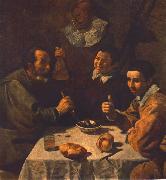 |
VELAZQUEZ, Diego Rodriguez de Silva y -- Click Here
|
|
Spanish Baroque Era Painter, 1599-1660
Spanish painter. He was one of the most important European artists of the 17th century, spending his career from 1623 in the service of Philip IV of Spain. His early canvases comprised bodegones and religious paintings, but as a court artist he was largely occupied in executing portraits, while also producing some historical, mythological and further religious works. His painting was deeply affected by the work of Rubens and by Venetian artists, especially Titian, as well as by the experience of two trips (1629-31 and 1649-51) to Italy. Under these joint influences he developed a uniquely personal style characterized by very loose, expressive brushwork. |
|
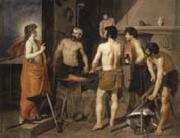 |
Velasquez -- Click Here
|
|
1599-1660,Spanish painter. He was apprenticed to Francisco Herrera the Elder before being trained by Francisco Pacheco. His early works were mostly religious or genre scenes. After arriving in Madrid in 1623, he painted a portrait of Philip IV that won him immediate success and an appointment as court painter. His position gave him access to the royal collections, including works by Titian, who exerted the greatest influence on his style. In his portraits from this period, only the faces and hands of the figures are accentuated, and the dark figures stand out against a light background. A visit to Italy (1629 ?C 31) further developed his style, and on his return to Madrid he entered his most productive period. Velazquez created a new type of informal royal portrait for Philip hunting lodge, and his portraits of court dwarfs display the same discerning eye as those of his royal subjects. On a second visit to Rome (1649 ?C 51) he painted a portrait of Pope Innocent X. The powerful head, brilliant combinations of crimson of the curtain, chair, and cope are painted with fluent technique and almost imperceptible brushstrokes that go far beyond the late manner of Titian and announce the last stage in Velazquez development. This portrait was copied innumerable times and won him immediate and lasting renown in Italy. In his last years he created his masterpiece, Las Meninas (The Maids of Honour, 1656). In this casual scene, the artist is shown painting the king and queen in the presence of the infanta Margarita and her attendants; the nearly life size figures are painted in more or less detail according to their relation to the central figure of the infanta and to the source of light, creating a remarkable illusion of reality never surpassed by Velazquez or any other artist of his age. He is universally acknowledged as one of the giants of Western art. |
|
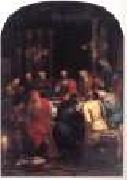 |
VEEN, Otto van -- Click Here
|
|
Flemish painter (b. 1556, Leiden, d. 1629, Bruxelles).
Flemish painter and draughtsman of Dutch birth. Although born in Holland, he is regarded as an artist of the Catholic southern Netherlands, where he spent most of his active life. He seems to have been acquainted with most of the Netherlandish scholars of his time, and his works testify to his broad humanistic learning. This and his prominent role in the early manifestations of the Counter-Reformation in Antwerp may have led Rubens to choose him as a teacher. Van Veen's importance as an artist has often been compared to the career of his famous pupil, for whom he was certainly the most important exemplar of the pictor doctus or learned painter. Van Veen obviously represents the older generation's more classicizing and conservative response to the Counter-Reformation. For him, the return to the spiritual values of the past also implied a recovery of the pictorial style of the High Renaissance, with its deliberate borrowings from the paintings of such artists as Raphael and Correggio. |
|
 |
Vecchietta -- Click Here
|
|
Italian Early Renaissance Painter and Sculptor, ca.1410-1480
Italian painter, sculptor, goldsmith and architect. He was formerly believed to have been born c. 1412 in the Tuscan town of Castiglione d'Orcia, but del Bravo has identified him with the Lorenzo di Pietro di Giovanni who was baptized in Siena in 1410. His name appears in a list of the members of the Siena painters' guild in 1428. From the evidence of later works he is generally supposed to have been apprenticed to Sassetta, but his early work has not been identified. Between c. 1435 and 1439 he executed for Cardinal Branda Castiglione (1350-1443) a series of frescoes at Castiglione Olona, near Varese in Lombardy. He has been considered an assistant of MASOLINO DA PANICALE in this enterprise, but the scenes of the martyrdoms of SS Lawrence and Stephen in the apse of the Collegiata, below Masolino's vault frescoes, show that Vecchietta's closely packed compositional style was already fully formed. He also painted the frescoes (partially published by Bertelli) in the chapel of the Cardinal's palace in the town, depicting the Evangelists (vault) and friezes of male and female saints (side walls). Although abraded and fragmentary, they nevertheless indicate the naturalistic effects of atmospheric lighting and foreshortening that, more than any other Sienese painter of his day, he had learnt from Masolino and the Florentine painters. |
|
|
|
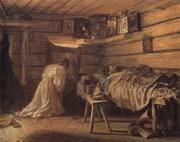 |
Vassily Maximov -- Click Here
|
|
Russian 1844-1911,was a Russian painter, a prominent member of the Peredvizhniki group. Maximov was born to a peasant family in the village of Lopino near Novaya Ladoga. He became an orphan early and worked for an Iconpainting shop, where he first learned to paint. In 1863 he entered the Imperial Academy of Arts and in 1864 he became a member of an Artel of Artists created by P.N. Krestonovtsev by the example of Ivan Kramskoi. The artel existed only one year and was then disbanded. Maximov painted the Sick Child (1864) at that time, when received a Gold Medal of the Academia. He completed all the courses of the Academy in three years. In 1865 he (like the group of fourteen led by Ivan Kramskoi had done earlier) refused to take part in the competitions for the Major Gold Medal by Academia. He argued that he did not need to study abroad (that was a part of the prize) but rather would study the Russian village. Indeed, after graduation from the Academia he moved to the village of Shubino, in the gubernia of Tver, where he painted the peasant life, earning money as a painting teacher of the Princes Golenischev Kutuzov (descendants of Mikhail Illarionovich Kutuzov). His painting Grandmother tales (1867) was shown at a Peredvizhniki exhibition, where it won a prize and was bought by Pavel Tretyakov. In 1872 he was admitted to the Peredvizhniki group, and soon became one of its most prominent and rigorous members. Ilya Yefimovich Repin described Maximov as the most uncrushable stone in the foundation of peredvizhnechestvo. Maximov painted many paintings of the peasant life. In the last twenty years of his life, realism paintings fell out of fashion. Maximov still painted almost exclusively scenes of the peasant lives that had almost no buyers. The artist lived a life full of poverty and illnesses. He died in Saint Petersburg. |
|
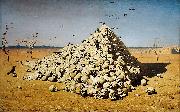 |
Vasily Vereshchagin -- Click Here
|
|
(Russian: October 26, 1842 - April 13, 1904) was one of the most famous Russian battle painters and one of the first Russian artists to be widely recognized abroad. The graphic nature of his realist scenes led many of them to never be printed or exhibited.
Vereshchagin was born at Cherepovets, Novgorod Governorate, Russia in 1842 as the middle of three brothers. His father was a landowner of noble birth. When he was eight years old he was sent to Tsarskoe Selo to enter the Alexander Cadet Corps, and three years later he entered the Sea Cadet Corps at St Petersburg, making his first voyage in 1858. He served on the frigate Kamchatka, which sailed to Denmark, France and Egypt.
Vereshchagin graduated first in the list at the naval school, but left the service immediately to begin the study of drawing in earnest. He won a medal two years later, in 1863, from the St Petersburg Academy for his Ulysses Slaying the Suitors. |
|
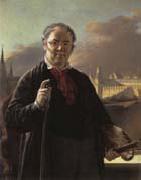 |
Vasily Tropinin -- Click Here
|
|
1776-1857
Russian painter. He was born a serf and in 1790 was apprenticed to a pastrycook in St Petersburg. From 1793 he attended classes at the Academy of Art there, in 1799 becoming a pupil of the portrait painter Stepan Shchukin (1762-1828). In 1804 he was sent to work as a pastrycook and manservant on an estate in the Ukraine owned by his master, General Morkov. Tropinin's Ukrainian period (1804-21) was interrupted by frequent, often protracted, visits to Moscow. During these years he copied a great deal, drew landscapes from nature and also painted religious subjects. His early style is painterly and distinguished by freedom of execution and skill in the use of colour, but the compositions are derivative and the drawing weak: The Spinner (1820s), The Lacemaker (1823), Wedding in the Village of Kukavka, Podolsky Province and Girl with a Bird (all Moscow, Tret'yakov Gal.). Portraiture, however, began to take on a more important place in his work; the best of this period is the Portrait of Arseny, the Artist's Son (1818; Moscow, Tret'yakov Gal.), especially notable for its use of colour. Tropinin captured perfectly the child's spontaneous vision of the world, his sensitive spirit and openness. While in Moscow from 1813 to 1818, he portrayed a series of important cultural figures that brought him great popularity. He was freed from serfdom on 8 May 1823 and shortly thereafter he became a nominee to the Academy for his paintings The Lacemaker |
|
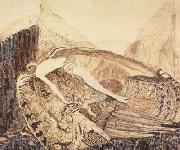 |
Vasily Surikov -- Click Here
|
|
Russian Painter, 1848-1916
Russian painter. He is principally noted for his treatment of episodes from the 17th century and the medieval period of Russian history. These works are remarkable for their thoroughly researched and detailed rendering of settings and costume and the drama of their presentation. Surikov was also an accomplished portrait painter and incorporated a large number of portrait studies into his history paintings. |
|
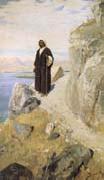 |
Vasily Polenov -- Click Here
|
|
1844 - 1927,Painter. He began a systematic study of drawing in 1856, first with the landscape painter Pavel Cherkasov (1834-1900), then from 1859 to 1861 with Pavel Chistyakov (1832-1919). He also took lessons with Chistyakov, whom he considered his most important teacher, in 1871 and early 1872, after finishing his academic course. From 1863 to 1871 Polenov studied at the St Petersburg Academy of Art, where he met members of the progressive wing of the Russian artistic intelligentsia, and occasionally in the faculty of law at St Petersburg University. The classical education he received at home, his academic training and lessons with Chistyakov led Polenov towards an exalted history painting, although he personally inclined towards landscape. This dualism remained in Polenov work for the duration, and not until the late 1880s and early 1890s did he achieve a stable relationship between the two forms. The whole of his student career and the initial postgraduate, scholarship period was largely taken up with historical works: from academic compositions, for example the Resurrection of Jairus Daughter (1871; Pskov, Mus. Hist., Archit. & A.), for which he received the Grand Gold Medal and a travel bursary (in Germany and Italy, 1872-3, and France, 1873-6), to numerous pictures and sketches on subjects from antiquity and medieval history, executed in France or shortly after his departure from there, under the perceptible influence of Paul Delaroche (e.g. The Master Right, 1874; Moscow Tret yakov Gal.). At the same time he produced his first independent works, in the 1860s and early 1870s: landscapes in the surroundings of the Imochentsy estate in Karelia (e.g. Mountains, 1870; Moscow Tret yakov Gal.), and landscape studies and pictures executed from nature in Normandy in 1874 (e.g. Fishing Boat, Etretat; Moscow, Tret'yakov Gal.). In 1876 he became an Academician |
|
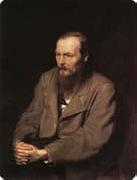 |
Vasily Perov -- Click Here
|
|
Russian historical, genre, and portrait Painter , 1834-1882
was a Russian painter and one of the founding members of Peredvizhniki, a group of Russian realist painters. Vasily Perov was born January 2, 1834 (December 21 1833 Old Style) in Tobolsk. After completing a course at Arzamas uezd school, he was transferred to the Alexander Stupin art school also located in Arzamas. In 1853 he was admitted to the Moscow School of Painting, Sculpture and Architecture, where he learned from several renowned artists. In 1856 he was awarded with a minor silver medal for his sketch of a boy's head, presented to the Imperial Academy of Arts. Later the Academy awarded him many other awards: in 1857 a major silver medal for Commissary of Rural Police Investigating, a minor golden medal for the Scene on a Grave and the Son of a dyak promoted to first rank, in 1861 a major golden medal for Sermon in a Village. After receiving the right to a state-paid trip abroad together with a golden medal, in 1862 Perov went to Western Europe, visiting several German cities, and then Paris. During this time he created paintings depicting scenes from European street life such as the Vendor of statuettes, the Savoyard, the Organ-Grinder in Paris, the Musicians and the Bystanders, the Paris Ragpickers. Returning to Moscow early, from 1865 to 1871 Perov created his masterpieces The Queue at The Fountain, A Meal in the Monastery, Last Journey, Troika, the Lent Monday, Arrival of a New Governess in a Merchant House, the Drawing Teacher, A Scene at the Railroad, the Last Tavern at Town Gate, the Birdcatcher, the Fisherman, the Hunters at Rest. In 1866 he received the title of an academician, and in 1871 the position of a Professor at Moscow School of Arts, Sculpture and Architecture. |
|
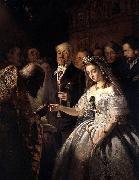 |
Vasiliy Pukirev -- Click Here
|
|
painted The Arranged Marriage in 1862 |
|
 |
Vasiliy Polenov -- Click Here
|
|
Vasily Dmitrievich Polenov (Russian: 1 June 1844 - 18 July 1927) was a Russian landscape painter associated with the Peredvizhniki movement of realist artists.
BiographyA native of St.Petersburg, Polenov studied under Pavel Chistyakov and in the Imperial Academy of Arts from 1863 to 1871. He was classmate and close friend to Rafail Levitsky, fellow Peredvizhniki artist and famous photographer. Their letters which remain today in Polenov's house museum are an interesting account of the many art exhibitions, movements and artists of their day. |
|
|
|
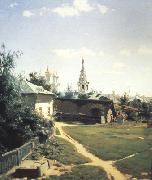 |
Vasilii Dmitrievich Polenov -- Click Here
|
|
1844-1927
|
|
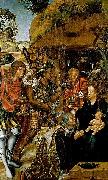 |
Vasco Fernandes -- Click Here
|
|
Vasco Fernandes (c.1475-c.1542), better known as Grão Vasco, was one of the main Portuguese Renaissance painters.
Vasco Fernandes was probably born in Viseu, in Northern Portugal, where he began his career in the team of painters executing the main altarpiece of Viseu Cathedral (1501-1506). Between 1506 and 1511 he painted the main altarpiece of Lamego Cathedral. After working in the Santa Cruz Monastery of Coimbra, Vasco Fernandes returned to Viseu and executed a series of altarpieces for Viseu Cathedral, considered his main works.
Most of his paintings hang nowadays in the Grão Vasco Museum, in Viseu. |
|
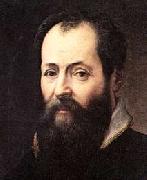 |
VASARI, Giorgio -- Click Here
|
|
Italian Mannerist Writer and Painter, 1511-1574
Italian painter, architect, and writer. Though he was a prolific painter in the Mannerist style, he is more highly regarded as an architect (he designed the Uffizi Palace, now the Uffizi Gallery), but even his architecture is overshadowed by his writings. His Lives of the Most Eminent Architects, Painters, and Sculptors (1550) offers biographies of early to late Renaissance artists. His style is eminently readable and his material is well researched, though when facts were scarce he did not hesitate to fill in the gaps. In his view, Giotto had revived the art of true representation after its decline in the early Middle Ages, and succeeding artists had brought that art progressively closer to the perfection achieved by Michelangelo. |
|
|
|
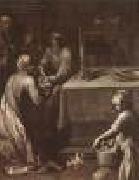 |
VARIN, Quentin -- Click Here
|
|
French Painter, ca.1570-1634
French painter. He was the son of a shoemaker and from 1597 to 1600 was in the papal territory of Avignon, where he worked with a local painter, Pierre Duplan ( fl late 16th century), enrolling also in the local painters' guild. By 1607 he had returned to northern France, and he was married that year at Amiens. In 1612 he was working in the Norman village of Les Andelys, and there he became Nicolas Poussin's first master. For the Gothic church of Notre-Dame, Le Grand Andely, he produced in 1612 a Martyrdom of St Vincent, a Martyrdom of St Clarus and a Regina Coeli (all in situ), the works that provided Poussin with his first contact with contemporary painting. These are the earliest fixed points in Varin's oeuvre, although a ruined Rock of the Philosophers (Rouen, Mus. B.-A.), reminiscent of such late 16th-century French Mannerist painters as Antoine Caron, |
|
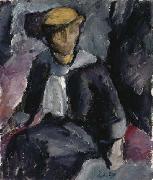 |
Valle Rosenberg -- Click Here
|
|
painted Sitting lady in 1913 |
|
|
|
 |
VALKENBORCH, Lucas van -- Click Here
|
|
Flemish painter (b. ca. 1530, Leuven, d. 1597, Frankfurt/Main).
|
|
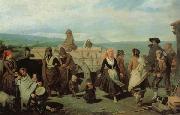 |
Valeriano Dominguez Becquer Bastida -- Click Here
|
|
Spanish , 1834-1870
|
|
 |
Valentine Cameron Prinsep Prints -- Click Here
|
|
Indian-born British Pre-Raphaelite Painter, 1838-1904
Henry Prinsep was an intimate friend of G. F. Watts, under whom his son first studied. Val Prinsep also worked in Paris in the atelier Gleyre; and 'Taffy' in his friend George du Maurier's novel Trilby, is said to have been sketched from him. He was an intimate friend of John Everett Millais and of Burne-Jones, with whom he travelled in Italy. He had a share with Rossetti and others in the decoration of the hall of the Oxford Union.
Prinsep first exhibited at the Royal Academy in 1862 with his Bianca Capella, his first picture, which attracted marked notice, being a portrait (1866) of General Gordon in Chinese costume. Princep lent the costume to Millais who used it in his own painting Esther.
The best of his later exhibits were A Versailles, The Emperor Theophilus chooses his Wife, The Broken Idol and The Goose Girl. He was elected A.R.A. in 1879 and R.A. in 1894. In 1877 he went to India and painted a huge picture of the Delhi Durbar, exhibited in 1880, and afterwards hung at Buckingham Palace. |
|
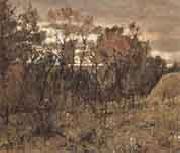 |
Valentin Serov -- Click Here
|
|
Russian Impressionist Painter, 1865-1911 |
|
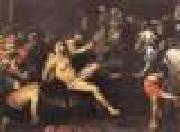 |
VALENTIN DE BOULOGNE -- Click Here
|
|
French Baroque Era Painter, ca.1594-1632 |
|
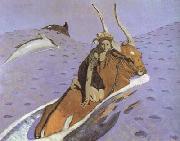 |
Valentin Aleksandrovich Serov -- Click Here
|
|
Russian Painter, 1865-1911
Russian painter, graphic artist and stage designer. As a child he lived in St Petersburg, but he made frequent trips abroad. In 1874 he travelled to Paris with his mother and frequented the studio of the Russian Realist painter, Il'ya Repin. In 1875 the art patron Savva Mamontov invited Serov and his mother to settle at ABRAMTSEVO outside Moscow, where he again had the opportunity to study under Repin and to meet other artists in the Mamontov circle. The Symbolist paintings of Mikhail Vrubel' and the late Impressionist landscapes and figure studies of Konstantin Korovin he saw at Abramtsevo had a lasting influence on the young Serov. From 1880 to 1885 he studied at the Academy of Art, St Petersburg, under Pavel Chistyakov (1832-1919). During the 1880s Serov also travelled abroad and became aware of French Impressionism. He began to use bright colours in portraits of figures seen in dappled sunlight and shade, as in his portrait of Vera Mamontov, Girl with Peaches (1887) and a portrait of Mariya Simonovich, Girl in Sunlight (1888; both Moscow, Tret'yakov Gal.). |
|
|
|
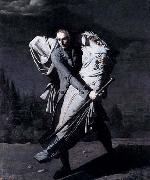 |
VAFFLARD, Pierre-Auguste -- Click Here
|
|
French painter b. 1777, Paris, d. 1837, Paris,French painter. A pupil of Jean-Baptiste Regnault, he exhibited regularly in the Salon between 1800 and 1831. He executed a number of unremarkable academic works on Classical subjects, for example Electra (1804; exh. Salon 1814) and Orestes Sleeping (1819; both Dijon, Mus. B.-A.). Vafflard gained more success with his Troubadour pictures, which he began to paint in the early 19th century, at the outset of this fashion. They are remarkable for their absence of colour, their theatrical quality and contrasted lighting effects. One of his earliest Troubadour scenes was Emma and Eginhard (exh. Salon 1804; Evreux, Mus. Evreux), based on an episode in the history of Charlemagne's court and painted at a time when the Holy Roman Empire was in fashion in official French circles. In this sentimental painting Vafflard demonstrated his historicizing intentions by emphasizing medieval costume and Gothic architecture and seeking to create an atmosphere similar to the romans de la chevalerie, so highly thought of in France at the end of the 18th century. In the same Salon he exhibited a strange and novel painting, Young Holding his Dead Daughter in his Arms (Angouleme, Mus. Mun.), taken from Edward Young's Night Thoughts (pubd in French in 1769-70). |
|
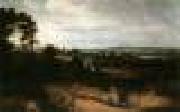 |
VADDER, Lodewijk de -- Click Here
|
|
Flemish painter (b. 1605, Bruxelles, d. 1655, Bruxelles)
Flemish painter, draughtsman, engraver and tapestry designer. He was received as a master in the Brussels Guild of St Luke on 15 May 1628, probably, like his brother Hubert de Vadder, after an apprenticeship to his elder brother, Philippe de Vadder (Coeckelberghs). Lodewijk is best known as a landscape painter, although he also executed landscape engravings and drawings. He was granted a privilege to make tapestry cartoons by the Brussels city magistrate in 1644. In this capacity he worked mainly for weavers such as Jean Courdijn and Baudouin van Beveren. The latter referred to him as the best landscape painter in the country |
|
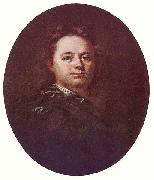 |
Vaclav Vavrinec Reiner -- Click Here
|
|
(Czech: Vaclav Vavřinec Reiner; 8 August 1686 or 1689 - 9 October 1743) was a Baroque painter who lived and died in Prague, Bohemia. |
|
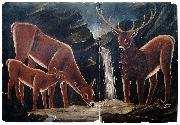 |
Vaclav Brozik -- Click Here
|
|
(5 March 1851 - 15 April 1901) was a Czech academic painter.
Since 1868 he studied at the Academy of Arts in Prague, Dresden, and Munich. In 1879 he went on study journey to the Netherlands.
He married a daughter of a wealthy art dealer in Paris, who helped him achieve success in French high society. He divided his time between Prague, where he taught at the Academy since 1893, and Paris. In 1896 he was elected as a foreign member and the successor of John Millais in the French Academie des beaux-arts. He died suddenly of cardiac failure and is buried at the Cimetiere de Montmartre.
|
|
|
|
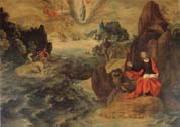 |
Tobias Verhaeght -- Click Here
|
|
1561-1631
was a painter and draughtsman active in Antwerp, Florence and Rome. Primarily a landscape painter, his style is indebted to mannerist world landscapes of artists like Joachim Patinir with high viewpoints, fantastic distant perspectives and three-colour scheme. Before Verhaecht entered Antwerp's guild of St. Luke in 1590?C91, he had already spent time in Italy, first in Florence, and then as a fresco painter in Rome. Peter Paul Rubens, who was a relative by marriage, studied with him around 1592, and another student was his own son, Willem van Haecht. |
|
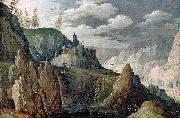 |
Tobias Verhaecht -- Click Here
|
|
(Antwerp, 1561 - 1631) was a painter and draughtsman active in Antwerp, Florence and Rome. Primarily a landscape painter, his style is indebted to mannerist world landscapes of artists like Joachim Patinir with high viewpoints, fantastic distant perspectives and three-colour scheme. Before Verhaecht entered Antwerp's guild of St. Luke in 1590-91, he had already spent time in Italy, first in Florence, and then as a fresco painter in Rome. Peter Paul Rubens, who was a relative by marriage, studied with him around 1592, and another student was his own son, Willem van Haecht. Verhaecht is also known for his designs for prints.
|
|
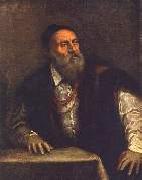 |
TIZIANO Vecellio -- Click Here
|
|
Italian painter, Venetian school (b. 1490, Pieve di Cadore, d.
1576, Venezia). |
|
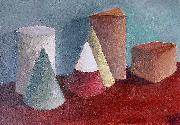 |
Tim Verfaillie -- Click Here
|
|
(Brugge, 14 January 1893 - Rochefort, 1934) was Belgian painter who was one of the smaller figures of Flemish expressionism.
In his younger days he travelled through the Scottish Highlands. The atmosphere he witnessed there would remain an important influence in his work.
|
|
|
|
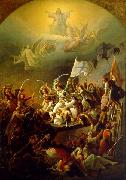 |
Theodoros Vryzakis -- Click Here
|
|
Thebes 19 October 1814 - Munich 6 December 1878) was a major Greek painter of the 19th century.
Vryzakis's father died in the Greek War of Independence. He is the first Greek painter who studied in Munich and the main representative of the type of historical painting that was popular in Greece in the 18th century.
He is considered the first painter of modern Greece, a recorder of the Greek War of Independence, which he viewed in a romantic and nostalgic way. His paintings' characters are pompous, theatrical and detached figures. His interest in the traditional costumes and the decoration and the absence of any individual facial expression is according to art critics the result of the eye of a "foreign" artist, who looks for the conventional element in another land. The monumental size of his pictures, the ceremonial and theatrical compositions, and the meticulous style of academic idealistic romanticism make his style unique for among Greek Artists. Today, many of his works are exhibited at the National Gallery of Athens and the Benaki Museum in Athens.
|
|
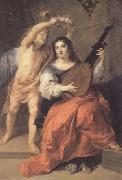 |
Theodor van Thulden -- Click Here
|
|
Flemish Baroque Era Painter, 1606-1669 |
|
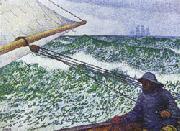 |
Theo Van Rysselberghe -- Click Here
|
|
Belgian Pointillist Painter, 1862-1926
was a Belgian neo-impressionist painter, who played a pivotal role in the European art scene at the turn of the century. Born in Ghent to a French-speaking bourgeois family, he studied first at the Academy of Ghent under Theo Canneel and from 1879 at the Academy of Brussels under the directorship of Jean-François Portaels. The North African paintings of Portaels had started an orientalist fashion in Belgium. Their impact would strongly influence the young Theo van Rysselberghe. Between 1882 and 1888 he made three trips to Morocco, staying there a total of one year and half. Barely 18 years old, he already participated at the Salon of Ghent, showing two portraits. Soon afterwards followed his Self-portrait with pipe (1880), painted in somber colours in the Belgian realistic tradition of that time. His Child in an open spot of the forest (1880) already departs from this style and he sets his first steps towards impressionism. |
|
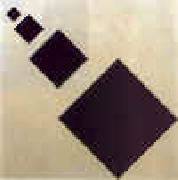 |
Theo van Doesburg -- Click Here
|
|
Dutch
1883-1931
Dutch painter, architect, designer and writer. He was officially registered as the son of Wilhelm Kepper and Henrietta Catharina Margadant, but he was so convinced that his mother second husband, Theodorus Doesburg, was his father that he took his name. Little is known of his early life, but he began painting naturalistic subjects c. 1899. In 1903 he began his military service, and around the same time he met his first wife, Agnita Feis, a Theosophist and poet. Between about 1908 and 1910, much influenced by the work of Honor Daumier, he produced caricatures, some of which were later published in his first book De maskers af! (1916). Also during this period he painted some Impressionist-inspired landscapes and portraits in the manner of George Hendrik Breitner. Between 1914 and 1915 the influence of Kandinsky became clear in such drawings as Streetmusic I and Streetmusic II (The Hague, Rijksdienst Beeld. Kst) and other abstract works. |
|
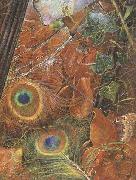 |
The Hon.Eleanor Vere Boyle -- Click Here
|
|
1825-1916
|
|
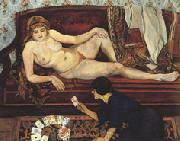 |
Suzanne Valadon -- Click Here
|
|
French Post-Impressionist Painter, 1865-1938
French painter and artist's model. She led a lonely childhood in Paris as the daughter of an unmarried and unaffectionate maid, seeking refuge from her bleak circumstances by living in a dream world. While residing in the Montmartre district of Paris, she became an artist's model, working in particular with those painters who frequented the Lapin Agile. From 1880 to 1887, for example, she sat regularly for Pierre Puvis de Chavannes, posing for both the male and female figures in the Sacred Wood (1884-6; Lyon, Mus. B.-A.). She also modelled for Renoir, Luigi Zandomeneghi, Th?ophile Steinlein, Jean-Louis Forain, Giuseppe De Nittis and Jean-Jacques Henner. No longer able to tolerate the passive role of the model, |
|
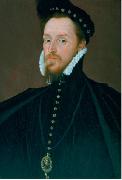 |
Steven van Herwijck -- Click Here
|
|
(Utrecht c. 1530-London 1565/67), was a Netherlandish sculptor and gem engraver famous for his portrait medallions and medals. It has recently been suggested that he is the "famous paynter Steven" mentioned in an inventory of 1590, who has traditionally been identified as Steven van der Meulen.
Van Herwijck worked in Italy in 1557 and returned to Utrecht in 1558, when he was made a Master of the artists' Guild of St. Luke. His earliest surviving medals, of George van Egmond, Bishop of Utrecht, and Engelken Tols, date from this year. In 1559 he relocated to Antwerp. Nine medals survive of his work there, including a portrait of Jacobus Fabius. Fleeing religious persecution, he went to Poland in 1561 where he made medallions of King Sigismund II and other members of the Polish royal family. |
|
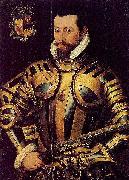 |
Steven van der Meulen -- Click Here
|
|
(b. eAntwerp - d. London, e1563-64) was a Dutch artist active c. 1543-1564. He gained prominence in England in the first decade of the reign of Elizabeth I as one of many Flemish artists active at the Tudor court. He is best known for the "Barrington Park" portrait type of Elizabeth I and for three-quarter length portraits of members of the English court in the first half of the 1560s. A recently discovered will indicates that he died in London between October 1563 and January 1564.
|
|
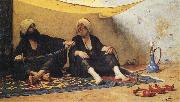 |
Stephen Wilson Van Schaick -- Click Here
|
|
American, 1848 - 1920 |
|
 |
STEINLE, Edward Jakob von -- Click Here
|
|
Austrian painter
b. 1810, Wien, d. 1886, Frankfurt |
|
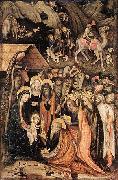 |
Stefano da Verona -- Click Here
|
|
Stefano da Verona. Dating to 1434, it is currently housed in the Pinacoteca di Brera of Milan, northern Italy.
|
|
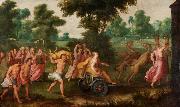 |
STALBEMT, Adriaan van -- Click Here
|
|
Flemish painter, Antwerp school
b. 1580, Antwerpen, d. 1662 |
|
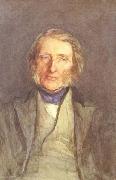 |
Sir Hubert von Herkomer,RA,RWS -- Click Here
|
|
1849-1914
|
|
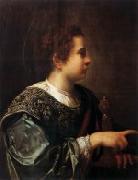 |
Simon Vouet -- Click Here
|
|
b. 1590, Paris, d. 1649, Paris.French painter and draughtsman. Although at the time regarded as one of the leading French painters of the first half of the 17th century, he is now known more for his influence on French painting than for his actual oeuvre. He made his reputation in Italy, where he executed numerous portraits for aristocratic patrons and was commissioned for religious subjects. Although the early Italian works show the influence of Caravaggio, his work was subsequently modified by the Baroque style of such painters as Lanfranco and the influence of the Venetian use of light and colour. |
|
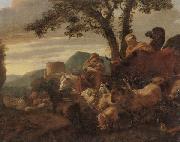 |
Simon van der Does -- Click Here
|
|
Dutch , Amsterdam circa 1653-after 1718
|
|
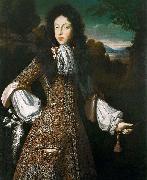 |
Simon Pietersz Verelst -- Click Here
|
|
(1644, The Hague - 1710, London), was a Dutch Golden Age painter.
According to the RKD he was the son of Pieter Harmensz Verelst and became a pupil in the Confrerie Pictura at the same time as his brother Herman in 1663. In 1668 he moved to London and called himself "the God of Flowers", but is known for portraits as well as flower and fruit still life paintings. |
|
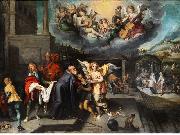 |
Simon de Vos -- Click Here
|
|
Simon de Vos (Antwerp, 20 October 1603-15 October 1676, Antwerp) was a Flemish Baroque painter of genre and cabinet pictures.
De Vos studied with Cornelis de Vos (1603-76), to whom he is not related, from 1615 until 1620. In 1620 he joined Antwerp's guild of St. Luke, and then he probably travelled to Rome where he came under the influence of the "low-life" genre paintings of the Bentvueghels and the bambocciate. A Caravaggesque influence, by way of the German painter Johann Liss active in Italy during the 1620s is discernible in De Vos's paintings from this time on. In contrast to the earlier "low-life" paintings, works from the late 1620s until around 1640, which were made after returning to Antwerp, are mostly small "merry company" and courtly genre scenes reminiscent of contemporary Dutch painters Dirck Hals and Pieter Codde. After 1640, De Vos turned away from genre scenes altogether and painted mostly small cabinet paintings of history subjects, influenced stylistically at first by Peter Paul Rubens and then increasingly by Anthony van Dyck. Examples include The Beheading of St. Paul (1648) in the Royal Museum of Fine Arts, Antwerp.
He married Catharina van Utrecht, the sister of Adriaen van Utrecht, in 1628. |
|
|
|
|
| | |
|
|
|
|